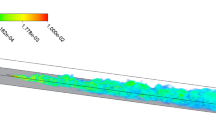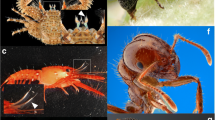Abstract
A variety of animals use olfactory appendages bearing arrays of chemosensory neurons to detect chemical signatures in the water or air around them. This study investigates how particular aspects of the design and behavior of such olfactory appendages on benthic aquatic animals affect the patterns of intercepted chemical signals in a turbulent odor plume. We use virtual olfactory `sensors' and `antennules' (arrays of sensors on olfactory appendages) to interrogate the concentration field from an experimental dataset of a scalar plume developing in a turbulent boundary layer. The aspects of the sensors that we vary are: (1) The spatial and temporal scales over which chemical signals arriving at the receptors of a sensor are averaged (e.g., by subsequent neural processing), and (2) the shape and orientation of a sensor with respect to ambient water flow. Our results indicate that changes in the spatial and temporal resolution of a sensor can dramatically alter its interception of the intermittency and variability of the scalar field in a plume. By comparing stationary antennules with those sweeping through the flow (as during antennule flicking by the spiny lobster, Panulirus argus), we show that flicking alters the frequency content of the scalar signal, and increases the likelihood that the antennule encounters peak events. Flicking also enables a long, slender (i.e., one-dimensional) antennule to intercept two-dimensional scalar patterns.
Similar content being viewed by others
References
Warhaft, Z.: 2000, Passive scalars in turbulent flows, Annu. Rev. Fluid Mech. 32, 203–240.
Fackrell, J. and Robins, A.: 1982, Concentration fluctuations and fluxes in plumes from point sources in a turbulent boundary layer, J. Fluid Mech. 117, 1–26.
Bara, B., Wilson, D. and Zelt, B.: 1992, Concentration fluctutation profiles from a water channel simulation of a ground-level release, Atmos. Environ. 26A, 1053–1062.
Crimaldi, J. and Koseff, J.: 2001, High-resolution measurements of the spatial and temporal structure of a turbulent plume, Exp. Fluids 31, 90–102.
Webster, D.R. and Weissburg, M.J.: 2001, Chemosensory guidance cues in a turbulent chemical odor plume, Limnol. Oceanog. 46(5), 1034–1047.
Atema, J.: 1985, Chemoreception in the sea: Adaptations of chemoreceptors and behavior to aquatic stimulus conditions, Soc. Exp. Biol. Symp. 39, 387–423.
Atema, J.: 1996, Eddy chemotaxis and odour landscapes: Exploration of nature with animal sensors, Biol. Bull. 191, 129–138.
Ache, B.: 1988, Integration of chemosensory information in aquatic invertebrates. In: J. Atema, R. Fay, A. Popper, and W. Tavolga (eds.), Sensory Biology of Aquatic Animals, pp. 387–401, Springer-Verlag, New York.
Weissburg, M.: 2000, The fluid dynamical context of chemosensory behavior, Biol. Bull. 198, 188–202.
Grunert, U. and Ache, B: 1988, Ultrastructure of the aesthetasc (olfactory) sensilla of the spiny lobster Panulirus argus, Cell Tissue Res. 251, 95–103.
Laverack, M.: 1988, The diversity of chemoreceptors. In: J. Atema, R. Fay, A. Popper, and W. Tavolga (eds.): Sensory Biology of Aquatic Animals. New York: Springer-Verlag, pp. 287–317.
Atema, J.: 1977, Functional separation of smell and taste in fish and crustacea. In: J. Le-Magnen and L. MacLeod (eds.), Olfaction and Taste IV. Information Retrieval, pp. 165–174, Information Retrieval, London.
Atema, J.: 1995, Chemical signals in the marine environment: Dispersal, detection and temporal analysis. In: T. Eisner and J. Meinwals (eds.), Chemical Ecology: The Chemistry of Biotic Interaction, pp. 147–159, National Academy Press, Washington D.C.
Gleeson, R.: 1982, Morphological and behavioral identification of the sensory structures mediating pheromone reception in the blue crab, Callinectes sapidus, Biol. Bull. 3163, 162–171.
Hallberg, E., Johansson, K. and Elofsson, R.: 1992, The aesthetasc concept: Structural variations of putative olfactory receptor cell complexes in crustaceans, Microsc. Res. Techn. 22, 336–350.
Atema, J. and Voigt, R.: 1995, Behavior and sensory biology. In: I. Factor (ed.), Biology of the Lobster Homarus americanus, pp. 313–348, Academic Press, New York.
Koehl, M.: 2001, Fluid dynamics of animal appendages that capture molecules: Arthropod olfactory antennae. In: Conference Proceedings of the IMA Workshop on Computational Modeling in Biological Fluid Dynamics.
Schmidt, B. and Ache, B.: 1979, Olfaction: Responses of a decapod crustacean are enhanced by flicking, Science 205, 204–206.
Moore, P., Gerhardt, G. and Atema, J.: 1989, High resolution spatio-temporal analysis of aquatic chemical signals using microelectrochemical electrodes, Chem. Senses 14, 829–840.
Moore, P., Atema, J. and Gerhardt, G.: 1991, Fluid dynamics and microscale chemical movement in the chemosensory appendages of the lobster, Homarus americanus, Chem. Senses 16, 663–674.
Gleeson, R., Carr, W.E.S. and Trapido-Rosenthal, H.G.: 1993, Morphological characteristics facilitating stimulus access and removal in the olfactory organ of the spiny lobster, Panulirus argus: insight from the design, Chem. Senses 18, 67–75.
Mead, K., Koehl, M.A.R. and O'Donnell, M.J.: 1999, Stomatopod sniffing: The scaling of chemosensory sensillae and flicking behavior with body size, J. Exp. Mar. Biol. Ecol. 241, 235–261.
Goldman, J. and Koehl, M.A.R.: 2001, Fluid dynamic design of lobster olfactory organs: Highspeed kinematic analysis of antennule flicking by Panulirus argus, Chem. Senses 26, 385–398.
Koehl, M., Koseff, J., Crimaldi, J.P., McCay, M.G., Cooper, T., Wiley, M.B. and Moore, P.A.: 2001, Lobster sniffing: Antennule design and hydrodynamic filtering of information in an odor plume, Science 294, 1948–1951.
Koehl, M.: 1996, Small-scale fluid dynamics of olfactory antennae, Mar. Fresh. Behav. Physiol. 27, 127–141.
Mead, K. and Koehl, M.A.R.: 2000, Stomatopod antennule design: The asymmetry, sampling efficiency, and ontogeny of olfactory flicking, J. Exp. Biol. 203, 3795–3808.
Koehl, M.: 2002, Transitions in function at low Reynolds number: Hair-bearing animal appendages, Math. Meth. Appl. Sci. (in press).
Stacey, M., Mead, K.S. and Koehl, M.A.R.: 2002, Molecule capture by olfactory antennules: Mantis shrimp, J. Math. Biol. (in press).
Gomez, G. and Atema, J.: 1996, Temporal resolution in olfaction: Stimulus integration time of lobster chemoreceptor cells, J. Exp. Biol. 199, 1771–1779.
Borroni, P. and Atema, J.: 1988, Adaptation in chemoreceptor cells I: self-adapting backgrounds determine threshold and cause parallel shift of response function, J. Compar. Physiol. A: Sens. Neural Behav. Physiol. 164, 67–74.
Borroni, P. and Atema, J.: 1989, Adaptation in chemoreceptor cells II: The effects of crossadapting backgrounds depends on spectral tuning, J. Compar. Physiol. A: Sens. Neural Behav. Physiol. 165(5), 669–678.
Barrett, T.: 1989, Nonintrusive optical measurements of turbulence and mixing in a stablystratified fluid. Ph.D. Thesis, University of California, San Diego.
Reid, R., Prausnitz, J. and Poling, B.: 1987, The Properties of Gases and Liquids. McGraw-Hill, Inc., New York.
Batchelor, G.: 1959, Small-scale variation of convected quantities like temperature in turbulent fluid, J. Fluid Mech. 5, 113–133.
Tennekes, H. and Lumley, J.: 1972, A First Course in Turbulence. The MIT Press, Cambridge.
Bendat, J. and Piersol, A.: 1986, Random Data: Analysis and Measurement Procedures, 2nd edition. John Wiley & Sons, Inc., New York.
Crimaldi, J.P., Wiley, M.B. and Koseff, J.R.: 2002, The relationship between mean and instantaneous structure in turbulent passive scalar plumes, J. Turbulence 3(014).
Freidrich, R.W. and Laurent, G.: 2001, Dynamic optimization of odor representations by slow temporal patterning of mitral cell activity, Science 291, 889–894.
Vickers, N.J., Christensen, T.A., Baker, T.C. and Hildebrand, J.G.: 2001, Odor-plume dynamics influence the brain' olfactory code, Nature 410, 466–470.
Author information
Authors and Affiliations
Rights and permissions
About this article
Cite this article
Crimaldi, J., Koehl, M. & Koseff, J. Effects of the Resolution and Kinematics of Olfactory Appendages on the Interception of Chemical Signals in a Turbulent Odor Plume. Environmental Fluid Mechanics 2, 35–64 (2002). https://doi.org/10.1023/A:1016279617858
Issue Date:
DOI: https://doi.org/10.1023/A:1016279617858




